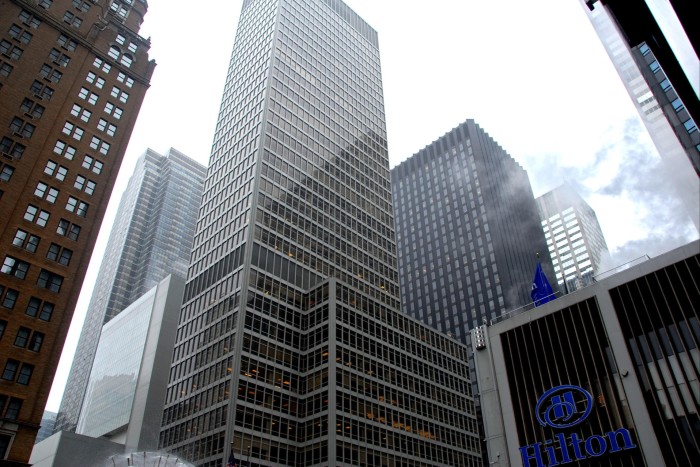Receive free Commercial property updates
We’ll send you a myFT Daily Digest email rounding up the latest Commercial property news every morning.
The 20-storey tower at 529 Fifth Avenue stands out from the other buildings around Grand Central Station for the surreal pink designs of an Alice in Wonderland-inspired art exhibit installed to fill vacant retail space on its ground floor.
It is also remarkable as one among a small number of towers that have recently changed hands, giving a clue as to the value of Manhattan’s older offices now that the commercial real estate sector has emerged from a historic era of ultra-cheap money.
Silverstein Properties sold the building three months ago for $105mn. In price per-square-foot terms, that was even less than a plot of land across the street commanded in 2015.
“In New York, buildings are selling for less than the value of the land they sit on,” said Will Silverman, managing director at Eastdil Secured, a real estate investment bank. “We are seeing prices lower than they have been in 20 years in absolute dollar terms.”
A long-anticipated reckoning is under way in the US commercial property industry, with the results playing out at 529 Fifth and other addresses. Sharply rising rates, a regional banking crisis that curtailed credit and a trend towards remote work are all wreaking havoc. Older office buildings have borne the brunt of the downturn, but other real estate categories have not been spared.

The results are evident in mounting strain around the country — from New York developers handing back obsolete office buildings to lenders, to foreclosures on heavily indebted apartment complexes in Houston and defaults on hotels and shopping malls in San Francisco. Banks, under scrutiny from regulators and investors, are now beginning to offload even performing property loans at a loss.
“I am not sure people have come to terms with how long the storm will hover and how much damage it will do,” said Scott Rechler, president of RXR, one of New York’s largest developers, likening the situation to a hurricane making landfall. “As for multifamily and other [commercial real estate], I believe that the markets are underestimating its potential severity.”
Craig Deitelzweig, chief executive of Marx Realty, said he was hearing of “new buildings every day” being returned to lenders. “It is the very beginning, but it seems that every asset class is at risk with these new interest rates and the very tight credit markets.”
Property developers and investors thrived during the era of low interest rates that followed the global financial crisis of 2008. When the Covid-19 pandemic struck they were then sustained by a prolonged period of leniency shown by lenders.
Now, broker JLL estimates that office buildings in New York — the world’s largest office market — have lost $76bn in value from their most recent sales prices. Seventy-three were now worth less than their loan balances. An exception is a new group of the most modern and luxurious offices, such as SL Green’s One Vanderbilt, which are fetching record rents.
More common are buildings like 1330 Avenue of the Americas. The Midtown property was recently sold by Blackstone and RXR for $320mn, a third less than the price it commanded in 2006.

Lenders have less flexibility to sustain troubled properties until conditions improve since, unlike in the downturn after the 2008 crisis, rising interest rates have squeezed buildings with insufficient income to cover loan payments. “We are absolutely in a credit crunch for offices,” said one investor.
One broker estimated that only the top 10 per cent of office buildings in New York were not distressed — either in terms of the level of debt or occupancy. “I think we are on the front edge of the forced sales,” this person said.
The financial damage may be masked because so few buildings have been sold in the past year, with deal volumes for commercial real estate down by more than half year on year in the first quarter, according to CBRE. That means that many owners have not been forced to update their valuations.
Still, there have been clues. Blackstone recently sold its stake in One Liberty Plaza, a skyscraper in lower Manhattan, to Brookfield in a deal that valued the tower at $1bn. That was down from the $1.55bn valuation in 2017, near the height of the market, when Blackstone bought its interest.
Blackstone said traditional US offices are less than 2 per cent of its global portfolio, down from more than 60 per cent in 2007 as it “intentionally pivoted” to other sectors.
Another Manhattan building, Tower 56, was unloaded in February for $110mn when the owner could not refinance its debt — down from the $158mn paid for it in 2008.
Sales may accelerate as more owners are forced to refinance. Nearly $900bn in US commercial property debt is coming due this year and next, according to MSCI, a financial data firm. If owners cannot refinance on reasonable terms, or are forced to inject millions of dollars in fresh capital, then they may opt to sell or simply walk away.
Offices are not the only sector under pressure. Some rental apartment properties — viewed as a safe bet during the pandemic — are also struggling.

In Houston, Applesway Investment Group bought four dated apartment complexes with nearly $230mn in floating rate debt beginning in 2021, hoping that it could raise rents. But it could not cover its payments after rates rose. Lender Arbor Realty Trust foreclosed on the properties in April.
The refinancing crunch is creating opportunities for a growing pack of alternative lenders to plug the gaps for otherwise viable properties. These lenders generally offer credit at higher rates, however.
“There’s going to be tonnes and tonnes of workouts,” Steven Stuart of Fortress Investment Group, one such lender, predicted at a conference hosted in May by The Real Deal, a real estate news outlet. “The basic problem is a lot of these assets were financed with short-term, floating rate debt a few years ago.”
Looming over any negotiations is uncertainty about the future of offices, the largest sector of commercial real estate. “Office is in the middle of a massive paradigm shift. We think it is going to take five-plus years to work out the fundamental shift in demand,” said Julie Ingersoll, chief investment officer at CBRE IM. “It is like no other real estate cycle we’ve seen in the past.”
Follow Us on Google News
















